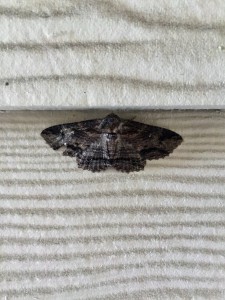This moth greeted me as I left my apartment a few days ago. I put the observation on iNaturalist right away under the “Butterflies and moths” category, hoping to properly identify it later. As I checked back a few hours later, someone had identified the genus for me; he placed this moth in the Zale genus. I further identified it as Zale lunata, but nobody has confirmed that ID yet.
Zale lunata, or lunate zale moths, are large moths in the Noctuidae family. They are very widespread across North America. Moths in this family are mostly nocturnal and attracted to lights at nighttime. Lunate zale moth adults have bodies that are varying shades of brown with wavy striations and bands of color across their wings. They also could have yellow, reddish brown, and black colors on their wings with grey or silver patches as well. Their appearances make is easy for them to blend in with the bark on trees and avoid predation. The caterpillars of this species feed on a variety of trees such as apple, plum, maple, and willow trees. Adults can be found in areas where these trees grow, such as in woodlands, orchards, and forests, as well as in yards and parks and by creeks and streams. Adults have a long flight season and have been seen throughout the year, but they are most common in the spring. An interesting fact about them is that the name lunata comes from the Latin name for moon; this was likely referring to the crescent shaped marks on the wings.
My iNaturalist post can be found here.
Sources:
http://www.insectidentification.org/insect-description.asp?identification=Lunate-Zale-Moth
http://sites.biology.duke.edu/dukeinsects/Zale_lunata.php
